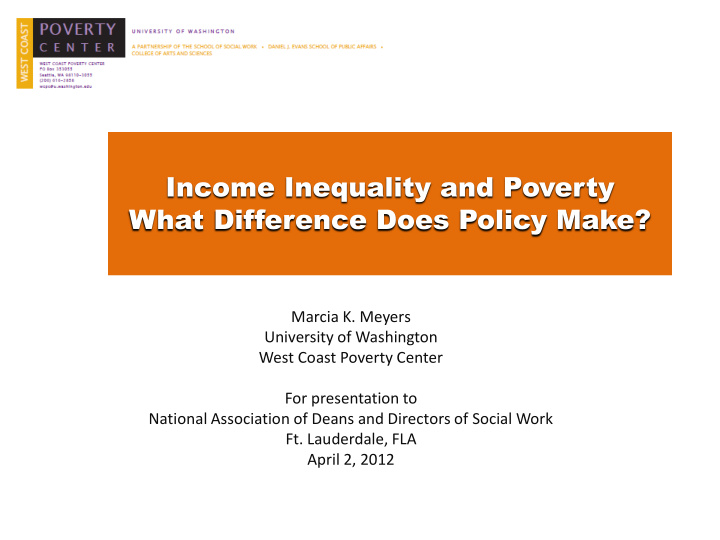



Income Inequality and Poverty What Difference Does Policy Make? Marcia K. Meyers University of Washington West Coast Poverty Center For presentation to National Association of Deans and Directors of Social Work Ft. Lauderdale, FLA April 2, 2012
TAKE AKE AWA WAY POINT Y POINTS S • Income inequality in US has increased steadily since the early 1980s and sharply since 2002. • Great Recession and recovery are increasing inequality • Economy matters: Market-based US system requires all adults to work to avoid hardship but returns from work are declining for lower 40-60% of household • Policy matters : Government tax and transfer policies reduce inequalities in market incomes but have been declining in effectiveness
Income Inequality has grown Change in Household Income Shares by Quintile Comprehensive Income Measure, 1979-2007 140 120 100 Percentage Change Lowest Quintile 80 60 Middle Quintile 40 Highest Quintile 20 Top 1% 0 -20 -40 1979 1981 1983 1985 1987 1989 1991 1993 1995 1997 1999 2001 2003 2005 2007 Source: CBO 2010
Why hy did did ineq inequa uali lity ty grow so w so dr dram amatic ticall ally? y? • Factors putting downward pressure on wages for less skilled/educated workers • Factors limiting employment opportunities and hours for adults in low income households • Factors increasing returns to education in higher wages and total market earnings in the most highly compensated jobs • Factors increasing returns to capital investments and ownership among most affluent households
Wha hat t impac impact t ha has s th the e Gr Grea eat t Rec eces ession sion ha had d on on i ine nequ quality? ality?
US UNEMPLOYMENT RATE Per ercent cent Civ Civilian Adult ilian Adult (o (over a er age 16) ge 16) P Popula opulation tion Unemplo Unemployed, ed, Januar anuary y 2005 2005-2012 2012 OFFICIAL MEASURE PERCENT reporting that they do not have a job, have actively looked for work in prior 4 weeks & are available for work. Source: US Bureau of Labor Statistics
US UNEMPLOYMENT RATE Per ercent cent Civ Civilian Adult ilian Adult (o (over a er age 16) ge 16) P Popula opulation tion Unemplo Une mployed ed or or Discour Discouraged ged, , Janu anuar ary 2005 y 2005-2012 2012 PLUS DISCOURAGED WORKERS PERCENT reporting they want a job, have looked for work in last 12 months, are available for work but are not currently looking for work because they believe no job is available, have been unable to find work, lack necessary skills or training, or face some form of discrimination Source: US Bureau of Labor Statistics
US UNEMPLOYMENT RATE Per ercent cent Civ Civilian Adult ilian Adult (o (over a er age 16) ge 16) P Popula opulation tion Unemplo Unemployed ed or or Und Under eremplo employed, ed, Janu anuar ary y 200 2005-2012 2012 PLUS UNDEREMPLOYED PERCENT employed part time for economic reasons; reporting that they want and are available for full- time work but have had to settle for part-time schedules. Source: US Bureau of Labor Statistics
Wha hat impac t impact? t? • Increasing downward pressure on wages for less skilled/educated workers • Increasing employers’ use of nonstandard employment contracts, part-time schedules • Increasing opportunities and pressure to lower labor costs, lower price of consumer goods and services and increase returns to capital investments and ownership among most affluent households
What to Do? “The chief contribution of taxes to inequality reduction is indirect. Taxes provide the money to fund the transfers that reduce inequality. ... Not surprisingly, countries that significantly reduce inequality via transfers tend to tax more heavily .” Lane Kenworthy, U of AZ Source: lanekenworthy.net Luxembourg Income Study
Public p Public policies olicies REDUCE REDUCE mar market et inequality inequality thr through tax ough taxes & tr es & transf ansfer ers s “ Household income packages” : Market income + Centralized, national, social insurance + Decentralized, safety net programs -- Federal payroll & income taxes with credits -- State income taxes and credits Question: How do much do components reduce inequalities in market income?
Mar arket income et income by quintile by quintile Mid 2000s, all US households All Bottom 2nd 3rd 4th Top Households Quintile Quintile Quintile Quintile quintile 80,000 Household market income $ 60,000 40,000 20,000 0 Source: Meyers et al. 2011
House Household hold income income pac packa kage ge by by quintile quintile Adjusted for taxes, social insurance & transfers Mid 2000’s, all households All Bottom 2nd 3rd 4th Top Households Quintile Quintile Quintile Quintile quintile Household Income Package $ 100,000 80,000 60,000 40,000 20,000 0 -20,000 Market income Social Insurance Transfers Safety Net Transfers State Income Taxes Source: Meyers et al. 2011
Equaliza Equalization has tion has become less become less ef effectiv ective e in r in recen ecent y t year ears Measuring changes in income inequality: Gini Index Measure of the distribution of income within population Perfect equality = 0 Perfect inequality =1 * Reduction in Gini coefficient reflects decrease in inequality
Gini Index Mid 2000s, all US households Net inequality Inequality in market income Social Insurance Transfers Safety Net Transfers Gini Index State Taxes Federal Taxes Net inequality Reduction in inequality 0 0.2 0.4 0.6 0.8 1 Source: Meyers et al. 2011
Gini Index mid 2000s by household type Net inequality Working Aged Hhs w/ Children Social Insurance Transfers Safety Net Transfers Working Aged Hhs w/o Children State Taxes Federal Taxes Elderly-headed Households 0 0.2 0.4 0.6 0.8 1 Source: Meyers et al. 2011
Gini Index for families with children, 1994 and 2004 Net inequality Increasing inequality in market income Social Insurance 2004 Transfers Safety Net Transfers Declining reduction in inequality State Taxes 1994 Federal Taxes 0 0.1 0.2 0.3 0.4 0.5 Source: Meyers et al. 2011
Why Should Social Work Care About Inequality? What Should Social Work Do About Inequality?
Recommend
More recommend